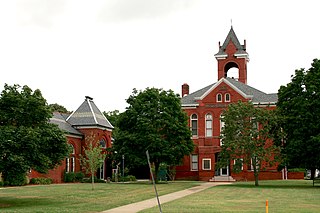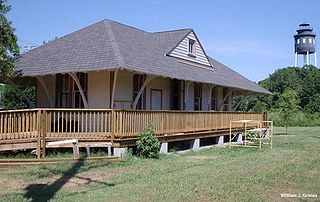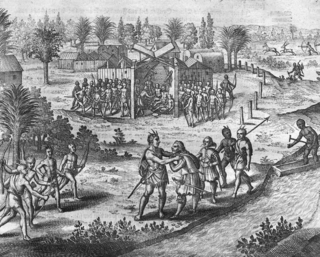
Northampton County is a county located in the Commonwealth of Virginia. As of the 2020 census, the population was 12,282. Its county seat is Eastville. Northampton and Accomack Counties are a part of the larger Eastern Shore of Virginia.

Accomack County is a United States county located in the eastern edge of the Commonwealth of Virginia. Together, Accomack and Northampton counties make up the Eastern Shore of Virginia, which in turn is part of the Delmarva Peninsula, bordered by the Chesapeake Bay and the Atlantic Ocean. Accomac is the county seat.

Accomac is a town in and the county seat of Accomack County, Virginia, United States. The population was 526 at the 2020 census.

The Eastern Shore of Virginia is the easternmost region of the Commonwealth of Virginia in the United States. It consists of two counties on the Atlantic coast. It is detached from the mainland of Virginia by the Chesapeake Bay. The 70-mile-long (110 km) region is part of the Delmarva Peninsula. Its population was 45,695 as of 2020.

Francis Makemie (1658–1708) was an Ulster Scots clergyman, considered to be the founder of Presbyterianism in the United States of America.

Colonel Edmund Scarborough was an English-born politician and military officer who served as speaker of the Virginia House of Burgesses from 1645 to 1646.

William Stone was an English-born merchant, planter and colonial administrator who served as the proprietary governor of Maryland from 1649 to 1655.
Thomas Henry Bayly was a nineteenth-century politician, slave owner, lawyer and judge from Virginia, and the son of Congressman Thomas M. Bayly.

The eight Shires of Virginia were formed in 1634 in the Virginia Colony. These shires were based on a form of local government used in England at the time, and were redesignated as counties a few years later. As of 2007, five of the eight original shires were considered still extant in the Commonwealth of Virginia in essentially their same political form, although some boundaries and several names have changed in the almost 400 years since their creation.

The Debtors' Prison is a historic debtors' prison in Accomac, Virginia. Constructed in 1783 as a house for the Accomack County jailer, it is the oldest public structure in the county. It was converted to use as a debtors' prison in 1824, which purpose it served until 1849. The prison was added to the Virginia Landmarks Register and the National Register of Historic Places in 1976; along with structures in Worsham and Tappahannock, both in Virginia as well, it is one of only three debtors' prisons in the country on the National Register.
Lynwood Wayne Lewis Jr. is an American politician and lawyer. A Democrat, he was elected to the Virginia House of Delegates in November 2003, representing the 100th district, which consists of the Eastern Shore counties of Accomack and Northampton, and parts of the cities of Norfolk and Hampton.
The Accomac people were a historic Native American tribe in Accomack and Northampton counties in Virginia. They were loosely affiliated with the Powhatan Confederacy. Archeological and historical record suggest trading relationships between the Accomacs and the Powhatans as well as other related groups such as the Occohannocks.
Hancock Custis was a member of the Virginia House of Burgesses, the elected lower house of the colonial Virginia General Assembly from Accomack County, Virginia in 1710–1712.

Bowman's Folly, is a historic home located near Accomac, Accomack County, Virginia. Captain Edmund Bowman patented the land in 1664, the current structure was built about 1815 by General John Cropper Jr., who had been born in the house in 1755. Cropper ordered it demolished and a grander building erected after construction of a hill to allow better vistas during the War of 1812. The current building has a 2+1⁄2-story, main block with a 1+1⁄2-story wing. The main block has brick ends with interior end chimneys and frame fronts on the north and south. It has a64 gable roof with dormers. The front facade features a Palladian window and pedimented entrance porch. Also on the property are a frame kitchen, now connected to the main house by a hyphen; frame dovecote, and frame privy.

Accomac Historic District is a national historic district located at Accomac, Accomack County, Virginia. The district encompasses 158 contributing buildings in the town of Accomac, mainly grouped into two periods of construction. From its founding in 1786 through the second quarter of the nineteenth century, several residential, commercial, governmental, and religious structures were built in the core of Accomac, representing both high-style and vernacular examples of late Georgian, Federal, and Greek Revival styles. Notable structures surviving from this period include the rectory of St. George's Episcopal Parish ; the Seymour House (1791-1815); Roseland (1750-1850); Seven Gables (1786-1905); Rural Hill, and the Francis Makemie Presbyterian Church (1840). The second period of construction reflected in the town dates to the last quarter of the nineteenth century, when the arrival of the New York, Philadelphia, and Norfolk Railroad spawned renewed growth and economic prosperity in Accomack County following the Civil War. These buildings also display both high-style and vernacular expressions of Victorian Era styles, including Second Empire, Italianate, Gothic Revival, and Romanesque. Notable structures from this time period include Bayly Memorial Hall, the County Clerk's Office (1887), the Accomack County Courthouse (1899), and houses found in the Lilliston Avenue extension of the town built in the 1880s-1890s. There are also contributing structures dating from the first quarter of the twentieth century, including the Drummondtown Baptist Church (1914), Drummondtown United Methodist Church (1920), and the former hotel at the town square (1925).
The Eastern Shore Public Library is a library system that serves counties of Accomack and Northampton counties in Virginia. The library system is within Region 3 of the Virginia Library Association (VLA).
William Kendall Sr. (I) (1621-1686) was a British merchant, planter, military officer and politician who came to own considerable land on Virginia's Eastern Shore. He represented Northampton County several times before and after Bacon's Rebellion, and during 1685 became the 21st Speaker of the Virginia House of Burgesses while representing Accomack County.
John Custis II (Sr.) was a North American Colonial British merchant and planter who aligned with governor William Berkeley during Bacon's Rebellion and began a political career in which he served in both houses of the Virginia General Assembly and became one of the founders of the Custis family, one of the First Families of Virginia.

Thomas Savage was an English adventurer to the Virginia colony. At age thirteen he emigrated to the New World, and soon after lived with Powhatan as an cultural emmissary from 1608 to 1610. Savage became a Tidewater Algonquian interpreter for the English. Savage settled on the Eastern Shore of Virginia where he interacted with native leader Debedeavon. Thomas Savage was an ancient planter, married a tobacco bride, and had a son (John) that represented Northampton County, Virginia in the House of Burgesses.











